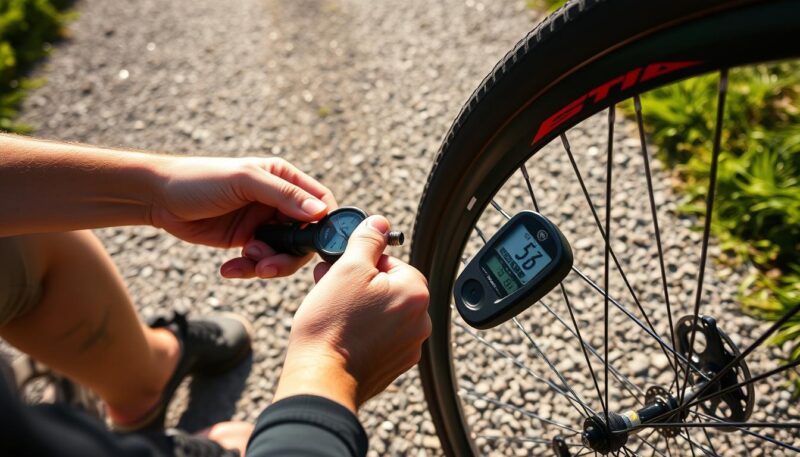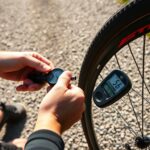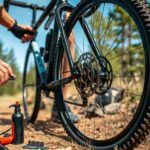Understanding how to adjust your bike tire pressure is essential for achieving the best performance and comfort while riding. Proper inflation enables you to enjoy a smooth, safe, and efficient biking experience, whether you’re commuting to work or embarking on a long road trip. The right pressure can significantly influence your bike’s handling, tire longevity, and overall ride quality. In this bike tire care guide, you’ll discover valuable insights into why maintaining optimal pressure is crucial, methods to adjust it, and essential maintenance tips to keep your bike’s tires in peak condition.
It’s not just about inflating tires; it’s about enhancing your adventure on two wheels. Imagine soaring down a hill on your road bike with perfectly balanced tires that grip the pavement effortlessly. Conversely, picture yourself grappling with the frustration of a flat tire due to improper inflation. It’s these little adjustments that make a world of difference in your cycling experience.
Throughout the following sections, you’ll learn about the importance of bike tire pressure, effective methods to adjust your tires, and essential maintenance tips that all riders, from casual users to seasoned cyclists, should know. Let’s dive into the heart of bike tire health and ensure your rides are not just enjoyable but also safe.
Understanding the Importance of Bike Tire Pressure
Maintaining proper tire pressure on bikes is crucial for ensuring optimal performance and safety. Correct tire pressure not only affects your bike’s speed and handling but also your comfort while riding. Cyclists often overlook this critical aspect of bike maintenance. Things can go awry if tire pressure is not within the recommended range, leading to performance drawbacks and safety risks.
Impact on Performance and Comfort
The importance of bike tire pressure cannot be stressed enough. Maintaining proper tire pressure impacts rolling resistance significantly. Higher pressure generally equates to lower rolling resistance, allowing for faster speeds on smooth surfaces. Yet, increased pressure may compromise comfort, especially on uneven terrain. Conversely, lower pressure can provide a more cushioned ride, crucial for handling rough paths but might slow you down. Here are some considerations:
- Higher tire pressure enhances speed but may cause discomfort.
- Lower tire pressure increases traction yet can lead to sluggish performance.
- Every bike type has unique pressure requirements; understand your specific needs.
Risks of Improper Inflation
Improper inflation poses significant risks to cyclists. Both overinflation and underinflation can lead to issues such as pinch flats and blowouts, which can not only interrupt your ride but also endanger safety. Regular checks are advisable to avoid these pitfalls:
“Improper tire pressure can drastically affect bike performance, leading to severe damages, especially for delivery riders.”
| Bike Type | Recommended PSI Range |
|---|---|
| Kids’ Bikes (12-inch) | 7-20 PSI |
| Mountain Bikes (26-inch) | 20-30 PSI |
| Road Bikes (700c wheels) | 80-120 PSI |
| Gravel Bikes (35-40mm tires) | 25-35 PSI |
Regularly checking and maintaining proper tire pressure on bikes through good practices and quality tools can offer riders an enhanced experience, optimal traction, and reduced rolling resistance. Take your bike tire maintenance tips seriously to ensure longevity and safety on every ride.
How to Adjust Your Bike Tire Pressure
Understanding how to adjust bike tire pressure is crucial for safety and performance. Proper inflation enhances comfort and efficiency while riding. This section will guide you through the different measurement systems, general PSI recommendations, and key factors to consider for effective adjustments.
Measuring Tire Pressure: PSI vs. BAR
When checking tire pressure, you might encounter two common measurement units: PSI (pounds per square inch) and BAR. PSI is the standard in the United States, while BAR is often used in Europe. You can find recommended pressure ranges on the tire sidewalls, usually indicated in both units. Knowing how to check and adjust tire pressure with the appropriate measuring tool will help you maintain optimal riding conditions.
General PSI Recommendations for Different Bike Types
Different bike types require varying tire pressures to perform efficiently. Here are some general recommendations:
- Road bikes: 80 to 130 PSI
- Mountain bikes: 30 to 50 PSI
- Hybrid bikes: 50 to 70 PSI
- Electric bikes: 4 to 5.5 BAR
- City bikes: 3.5 to 4.5 BAR
- Children’s bikes:
- 12-16 inch wheels: 2 to 3 BAR
- 18-20 inch wheels: 2.5 to 3.5 BAR
- 22-24 inch wheels: 3 to 4.5 BAR
Adjusting tire pressure based on these specifications ensures better traction and comfort across various terrains.
Factors to Consider When Adjusting Tire Pressure
A few factors significantly influence tire pressure adjustments:
- Rider Weight: Heavier riders typically require higher tire pressure. It’s advisable to add 1 PSI for every 10 pounds of rider weight.
- Temperature: Tire pressure can drop in colder temperatures, about 2% per 10-degree dip in Fahrenheit.
- Terrain: Depending on whether you are riding on smooth pavement or rough trails, ideal tire pressure may vary.
- Tire Width: Wider tires can be run at lower pressures to improve traction and comfort. For example, 2.1″ mountain bike tires should be within 18-26 PSI.
Experimenting with these factors can help you determine the optimal tire pressure tailored to your riding preferences. Knowing how to check and adjust tire pressure is an ongoing process that can enhance your cycling experience.
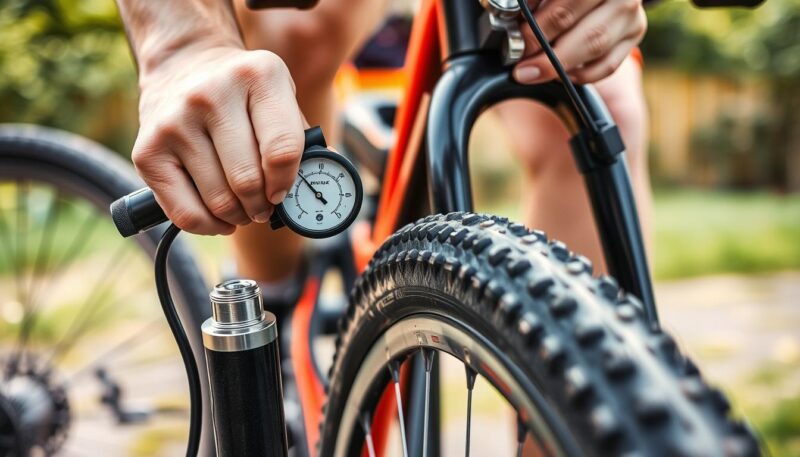
Bike Tire Maintenance Tips for Optimal Shape
Maintaining proper tire pressure on bikes is crucial for ensuring safety, performance, and comfort while riding. Follow these essential bike tire maintenance tips to keep your tires in great condition.
Regularly Checking Tire Pressure
It is essential to check your bike’s tire pressure at least once a week, especially for daily riders. Different bike tires have specific inflation requirements, which can vary greatly. For example, a road bike might operate at around 100 PSI while mountain bike tires can range from 12 to 34 PSI based on tire width and terrain. Be cautious about pinch flats that may occur when riding on underinflated tires, especially when hitting bumps.
Choosing the Right Pump and Gauge
Using the right pump and gauge can significantly improve your bike tire maintenance routine. Most Schwinn pumps offer a dual head that accommodates both Presta and Schrader valves, making them versatile for different types of bikes. Digital gauges often provide better accuracy compared to analog gauges, ensuring you are maintaining proper tire pressure on bikes effectively. Avoid using gas station air compressors, as they may be inaccurate for bike tire inflation.
Adjusting for Weight and Temperature Conditions
Adjust tire pressure based on rider weight and varying temperature conditions. Litespeed recommends different pressure ranges for road tires depending on both rider weight and tire width, ensuring an optimal balance of comfort and performance. Experimentation with tire pressure adjustments, typically in 2-3 PSI increments, is encouraged to determine the best settings for your riding style. Additionally, observe ride quality indicators like traction and responsiveness over bumps, making necessary adjustments as conditions change.
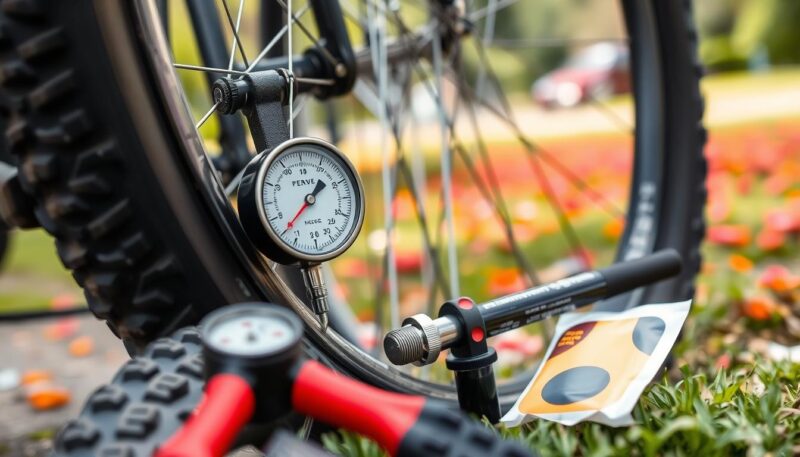
Conclusion
Maintaining the correct tire pressure is essential for maximizing your cycling experience. With proper inflation, you can improve cycling speed by up to 5%, as noted in studies. Utilizing the right pressure based on your bike type—whether it’s road, mountain, or hybrid—will enhance performance, safety, and comfort while riding. Remember that regular checks before each ride are crucial due to potential temperature changes that can affect pressure levels.
Incorporating tips for keeping your tires in optimal shape not only helps avoid accidents caused by flat tires but also ensures that you enjoy smoother rides with better traction and handling. While adjusting your tire pressure, consider the specific recommendations for your bike type: road bikes typically require 80-130 PSI, mountain bikes benefit from 30-50 PSI, and hybrids should be around 60-70 PSI. The right tire pressure equips you to tackle various terrains efficiently.
By taking these steps and committing to regular maintenance, you can significantly enhance your overall biking experience. It’s time to apply what you’ve learned on how to adjust your bike tire pressure and enjoy the ride with confidence. Always pay attention to your bike’s specific needs, as well as your personal preferences and riding conditions, for optimal enjoyment and performance on your cycling adventures.
